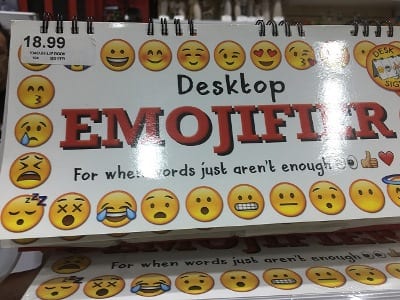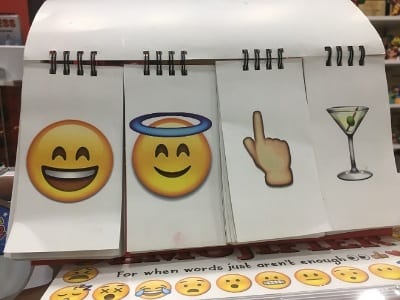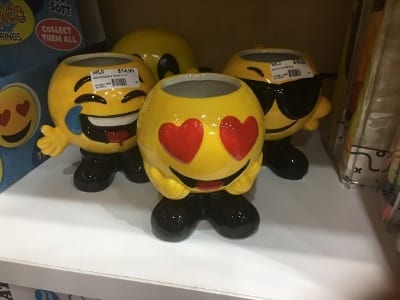These are desktop cards for communicating using emoji. The kind with cards that you can turn over to express what you want to say is interesting.
Emoji cushions and mugs
Of course, emoji are made up of symbols and pictures, so they can be commonly used worldwide, but I think there are some that have symbols that only Japanese use, some with Japanese writing, and some that are difficult for non-Japanese to understand. For example, there are foods like kushi dango (skewered rice dumplings), senbei (rice crackers), and naruto (a kind of fish paste). There is also a person bowing his head with his hands on the floor and hina doll, emoji for the post office, and on and on. As emoji come to be used more often, I think that Australians also wish there were certain emoji. I found an interesting article on emoji the other day. A questionnaire was given to Australians about what kind of emoji they’d like to see made. The top 20 were introduced, and I’ll share them here. They’re all emoji ideas characteristic of Australia, such as slang that I don’t quite get, buzzwords, and gags that only Australians would understand. I’ll explain them as I introduce them. In this blog, I’ll tell you about numbers 20 to 11.No. 20 YOLOYOLO stands for “You Only Live Once.”The emoji looks like the mark for a perfect score of 100. The 100 becomes the letters “yolo.”
No. 19 UteA ute (yūt) is an extremely popular car in Australia that has the front of a regular sedan and the back of a truck. Since the back is a truck bed, some people use it for its practicality, while others love it because it looks cool. Every car company sells this ute type of car. This emoji really is characteristic of Australia.No. 18 ThongA thong is a sandal (generally, beach sandals), so the emoji is a beach sandal. Australia probably ranks in the top worldwide for the number of people who wear beach sandals. Even in winter, it’s common for men and women of all ages to wear beach sandals (ha ha).No. 17 Sorry not sorryThis is a slightly sarcastic expression. “Sorry… (but not really because I don’t think I was wrong).”Japanese travelling overseas seem so modest and polite. Many Japanese are quick to say, “Sorry, sorry.” However, Australians don’t apologize so easily, even if they’re in the wrong…but, I think that they say thank you much more often than Japanese people. The emoji is below. A woman is raising her hand, which is positioned slightly low. Instead of smiling, the right corner of her mouth is raised in a sarcastic expression.
No. 16 SangerThis is a slang word for sandwich. In Japan, it’d be a rice ball, but in Australia it’s a sandwich.No. 15 Nonplussed faceThis shows a perplexed, distressed kind of face. The emoticon uses the Japanese character “he” for the mouth.No. 14 MeditatingThis emoji is a woman meditating with a serene expression and her thumb and pointer finger forming a circle. The fact that it ranked 14th was surprising.No. 13 Meat sweatThis emoji is a slice of steak that is sweating and has a distressed expression. Australians love meat, and it seems this refers to sweating after eating too much meat and is also a metaphor.No. 12 Meat pieThis, too, is representative of Australia. Just as the name says, a meat pie is stew-like meat or ground meat cooked in a piecrust. This emoji is a typical, round single-serving pie with tomato sauce (ketchup) on top.No. 11 Marriage equalityThis emoji feels like it’s part of the movement to demand acceptance for marriage equality for same-sex couples, which is not yet recognized in Australia. It’s two rainbow-colored wedding rings that are entwined.And there you have up to No. 11. In my next post, I’ll introduce numbers 10 to 1. Please look forward to it!




































































